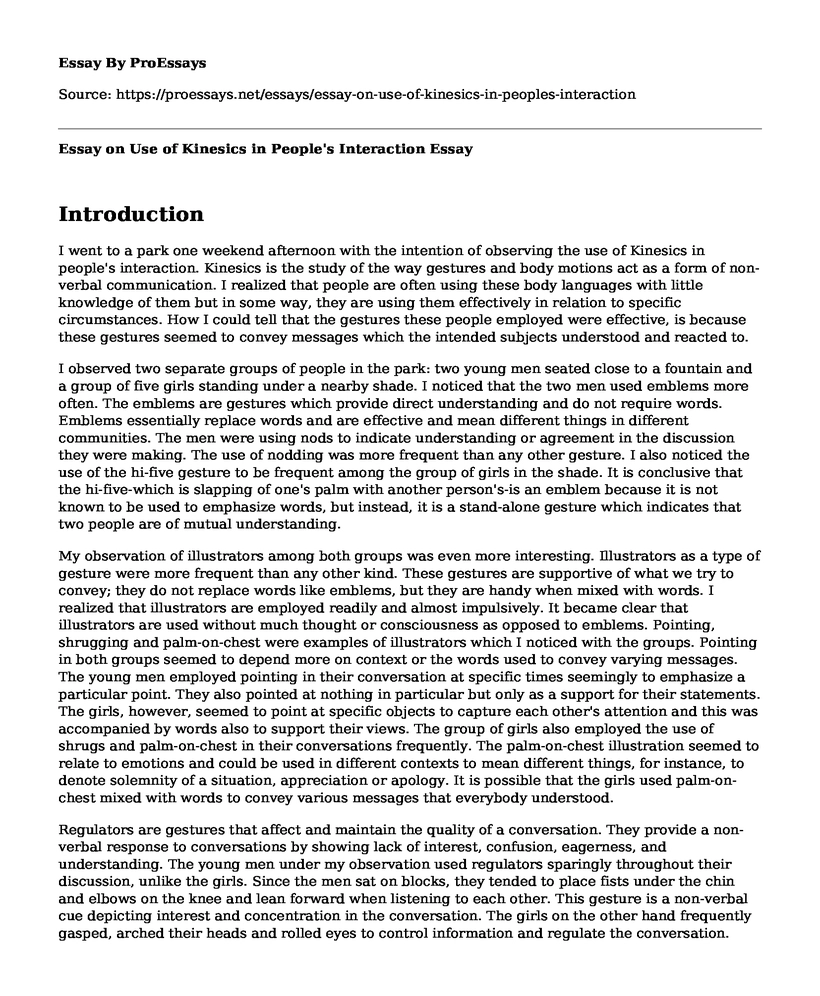Introduction
I went to a park one weekend afternoon with the intention of observing the use of Kinesics in people's interaction. Kinesics is the study of the way gestures and body motions act as a form of non-verbal communication. I realized that people are often using these body languages with little knowledge of them but in some way, they are using them effectively in relation to specific circumstances. How I could tell that the gestures these people employed were effective, is because these gestures seemed to convey messages which the intended subjects understood and reacted to.
I observed two separate groups of people in the park: two young men seated close to a fountain and a group of five girls standing under a nearby shade. I noticed that the two men used emblems more often. The emblems are gestures which provide direct understanding and do not require words. Emblems essentially replace words and are effective and mean different things in different communities. The men were using nods to indicate understanding or agreement in the discussion they were making. The use of nodding was more frequent than any other gesture. I also noticed the use of the hi-five gesture to be frequent among the group of girls in the shade. It is conclusive that the hi-five-which is slapping of one's palm with another person's-is an emblem because it is not known to be used to emphasize words, but instead, it is a stand-alone gesture which indicates that two people are of mutual understanding.
My observation of illustrators among both groups was even more interesting. Illustrators as a type of gesture were more frequent than any other kind. These gestures are supportive of what we try to convey; they do not replace words like emblems, but they are handy when mixed with words. I realized that illustrators are employed readily and almost impulsively. It became clear that illustrators are used without much thought or consciousness as opposed to emblems. Pointing, shrugging and palm-on-chest were examples of illustrators which I noticed with the groups. Pointing in both groups seemed to depend more on context or the words used to convey varying messages. The young men employed pointing in their conversation at specific times seemingly to emphasize a particular point. They also pointed at nothing in particular but only as a support for their statements. The girls, however, seemed to point at specific objects to capture each other's attention and this was accompanied by words also to support their views. The group of girls also employed the use of shrugs and palm-on-chest in their conversations frequently. The palm-on-chest illustration seemed to relate to emotions and could be used in different contexts to mean different things, for instance, to denote solemnity of a situation, appreciation or apology. It is possible that the girls used palm-on-chest mixed with words to convey various messages that everybody understood.
Regulators are gestures that affect and maintain the quality of a conversation. They provide a non-verbal response to conversations by showing lack of interest, confusion, eagerness, and understanding. The young men under my observation used regulators sparingly throughout their discussion, unlike the girls. Since the men sat on blocks, they tended to place fists under the chin and elbows on the knee and lean forward when listening to each other. This gesture is a non-verbal cue depicting interest and concentration in the conversation. The girls on the other hand frequently gasped, arched their heads and rolled eyes to control information and regulate the conversation.
Adaptors are body languages that happen almost unawares just like the illustrators, and they make us more comfortable in a conversational setting. One can distinguish adaptors from illustrators because the latter is used as part of the conversation while the former is independent and generally meaningless to the discussion. The men in the park employed sitting positions to adapt to their conversation and get comfortable. I noticed that the girls shifted from one foot to another to get comfortable; one of them seemed to sway gently showing she was either uncomfortable or losing interest in the conversation. The latter seemed the case since not long after, she hugged the others and left. One of the men scratched his head at some point which is somewhat ambiguous; it could depict uneasiness, or it could be meaningless.
Conclusion
The most common type of Kinesics I observed throughout the day was affect display. These are facial expressions which indicate or display effect of something, mostly emotions. It can be a smile, a laugh, a frown or a pout. Both groups used affect display throughout their conversations with varying frequency. Both groups laughed and smiled, but the men smiled more and laughed less, while the girls laughed and smiled frequently.
Cite this page
Essay on Use of Kinesics in People's Interaction. (2022, Apr 07). Retrieved from https://proessays.net/essays/essay-on-use-of-kinesics-in-peoples-interaction
If you are the original author of this essay and no longer wish to have it published on the ProEssays website, please click below to request its removal:
- Essay Example on Tourists and Stereotypes: Exploring the Impact on Travel
- Essay Example on Romantic Intimacy: Dreams, Hopes, and Expectations
- Open Borders: Re-Imagining Global Politics Beyond Country Limits - Essay Sample
- Mill's Sociological Imagination: Understanding Society & the Individual - Essay Sample
- Essay Example on Mayoruna Tribe: Religiousness and Way of Life
- Essay Sample on Older Adults in California: Challenges & Necessary Support
- Agenda Setting and Framing - Essay Sample







